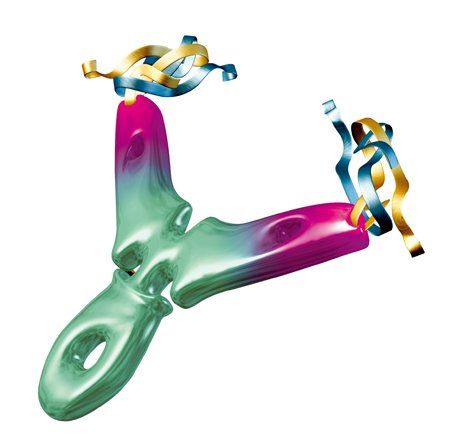SABCS: Adjuvant Bevacizumab Fails to Improve Invasive DFS for Triple-Negative Breast Cancer
Triple-negative breast cancer patients with primary invasive cancer did not benefit from adjuvant combination chemotherapy plus bevacizumab compared to chemotherapy alone.
Representation of bevacizumab molecule; source: Roche

Triple-negative breast cancer patients with primary invasive cancer did not benefit from adjuvant combination chemotherapy plus bevacizumab (Avastin) compared to chemotherapy alone. These are the preliminary results of the trial. David Cameron, MD, professor of oncology at Edinburgh University in Scotland presented the results at the San Antonio Breast Cancer Symposium (SABCS) held in Texas.
The 3-year invasive disease-free survival (DFS) was not statistically different between the two trial arms. Of patients given chemotherapy alone, 82.7% were invasive DFS at 3 years compared to 83.7% of those given bevacizumab in addition to chemotherapy. The hazard ratio for invasive DFS was 0.87 in favor of patients on the combination regimen. Patients were followed for a median of 32 months; 107 patients in the chemotherapy-alone arm died compared to 93 patients in the combination arm.
Cameron does not believe that the BEATRICE results strengthen or weaken the rationale to use bevacizumab in metastatic breast cancer. The results do highlight the need to find subgroups that could respond well to the therapy. “The women did better than we had expected and that is important news for women,” Cameron told Cancer Network. “Metastatic triple-negative breast cancer still has a horrible prognosis, but early triple-negative breast cancer may be cured more often than we originally thought.”
The phase III BEATRICE trial randomized 2,591 triple-negative breast cancer patients postsurgery to between four and eight cycles of a standard chemotherapy regimen: an anthracycline with or without taxane or a taxane-only regimen or a standard chemotherapy regimen given together with one year of weekly 5 mg/kg bevacizumab therapy. The chemotherapy regimen choice was left up to the physician. The trial aimed to test whether triple-negative breast cancer patients with a poor prognosis and few targeted treatment options would benefit from the addition of bevacizumab to their chemotherapy regimen. Patients in the trial were stratified based on their nodal stage, adjuvant chemotherapy, hormone receptor status, as well as surgery type (mastectomy or breast conservation).
Approximately 36% of all patients received anthracycline alone as their chemotherapy backbone, 5% received a taxane alone, and 59% were treated with a combination of both agents. The median age of patients in the trial was 50 and 63% of the patients did not have node-positive disease.
Patients in the bevacizumab arm had higher incidence of grade 3 hypertension (7% in the bevacizumab arm compared to less than 1% in the chemotherapy-alone arm during the chemotherapy phase of the trial), congestive heart failure and left ventricular dysfunction compared to those in the chemotherapy-alone arm. However, there was no difference in the increase in risk of fatal adverse events in patients taking bevacizumab.
The median follow-up time has been approximately 32 months. Further follow-up of patients on the trial will continue to assess the overall survival benefit if any of the combination therapy. These updated results, along with a biomarker analysis are expected to be reported sometime in 2013.
“We have not demonstrated a role in the adjuvant setting, but we have no new toxicity signals, and nothing to change the signals we have from other studies,” said Cameron. “We still don’t know how to identify the patient population, if it exists, that is acquisitively sensitive to bevacizumab.”
Previous trials with bevacizumab, including the RIBBON-1, RIBBON-2, AVADO, and the E2100 trials, had shown better progression-free survival in metastatic breast cancer patients when the antibody was combined with chemotherapy. Bevacizumab has also shown improved pathological complete response rates in the neoadjuvant setting.
The rationale for adding bevacizumab to chemotherapy treatment in the adjuvant setting in this trial was that the antiangiogenesis agent may block development or further growth of micrometastasis. Previous evidence has shown that micrometastasis development depends on the ability of blood vessels to form to provide circulation to the growing tumor.
The lack of a positive effect in triple-negative breast cancer underscores the need to better understand the biology of this subset of breast cancers and classify distinct subtypes within triple-negative breast cancers.
Clearly, bevacizumab is not appropriate for all triple-negative breast cancers. However, this is a heterogeneous disease and it is unsurprising that a single drug does not have a profound effect on efficacy, according to Dr. Cameron. “There may be a subgroup where bevacizumab will work.” New approaches to identify drugs that address the unique active pathways in triple-negative disease such as the PI3 kinase pathway as well as cell cycle pathways are needed. “My hunch is that it is in those two areas where we may find benefits, particularly if we can combine them with conventional chemo, which clearly has a role as well,” said Cameron.
Newsletter
Stay up to date on recent advances in the multidisciplinary approach to cancer.





